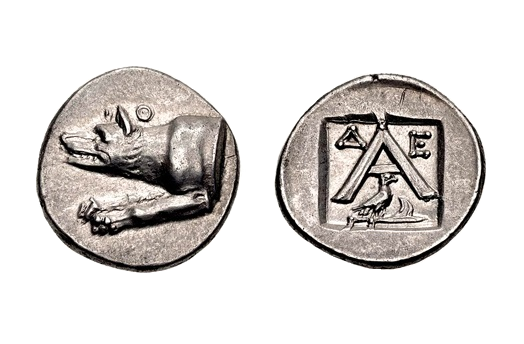
about ancient nomos
Ancient Nomos Art is a museum of galleries exhibiting ancient coins and ancient mint maps. The coin gallery displays the diverse art and history of hand-crafted ancient Greek, Roman, Byzantine, Persian and Medieval coinage. The ancient mints mapping gallery features Greek, Roman, Byzantine, Asia Minor and Medieval mint city regions and territories. Visitor's are welcome to explore, study and enjoy Ancient Nomos Art.

Greek, Argolis – 270 BC
Argolis, Argos
From Ancient Galleries

Obverse: Forepart of a Wolf at bay facing left; Θ (theta) above.
Reverse: Large A in center; Δ-E across in the upper field; below, eagle standing right on harpa.
LEGEND SYMBOLS
Obv: Forepart of a Wolf at bay facing left; Θ (theta) above. Rev: Large A (alpha) in center; Δ-E (delta epsilon) across in the upper field; below, eagle standing right on harpa right; all within incuse square.
The ancient Greek city of Argolis, Argos, was renowned in ancient mythological legends as one of the most ancient cities in the Peloponnesus. The city is located at the foot of a lofty hill overlooking a wide plain, bounded on the south by the broad sea of the Argolis Gulf. In the earliest historical times it is said to have been the center of an amphictyony of all the neighboring towns. The wolf is closely related to the local cult of Apollo Lykeios and is deeply rooted in the mythological tradition of the city. One of the most famous and magnificent buildings in ancient Argos was the sanctuary of the wolf god, Apollo Lykios. A wolf as the badge of the city is carried on the obverse of all Argos’ coin series. This wonderful coin is a silver triobol struck in Argos circa 270-250 BC. The obverse is the forepart of a wolf with a Θ above its neck. A wolf was said to have attacked the herd of grazing oxen before the walls of Argos. The people of Argos thought it was an omen and gave power to Danaus because just like the wolf, Danaus had never before been with the Argeians but prevailed over the leader of the herd, who, just like the current king of Argos Gelanor, had to yield. Danaus erected a temple to Apollon Lykeios and dedicated a cult statue (Pausanias 2.19.3-4). Wolves were offered as sacrificial victims (schol. Soph. El. 6). The wolf though could refer also to the hunting as appropriate activity of the Macedonian king. It was for this reason that the people of Argos chose the wolf as an emblem for their coinage, an instantly recognizable symbol of the great city. The reverse has a large letter A (alpha) centered within a square, an Δ-E monogram across the upper fields, and an eagle standing on a harpe below, all within the incuse square. The harpe was a type of sword with a sickle-like protrusion along one edge near the tip of the blade. The harpe is mentioned in many Greek and Roman sources and almost always in a mythological context.
DOCUMENTATION
Value: Triobol. Metal: AR Silver. Weight: 2.52 grams. Mint: Argolis, Argos. Date: Circa 270-260 BC.
Attribution: BCD Peloponnesos 1109–10; HGC 5, 670; British Museum Collection 79-80; Mycenae plate 10, 8-9.
Legend, Documentation and Attribution
